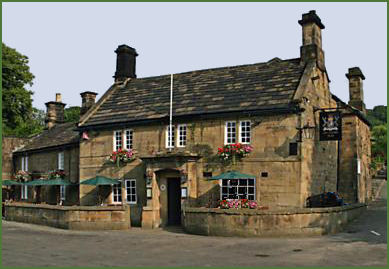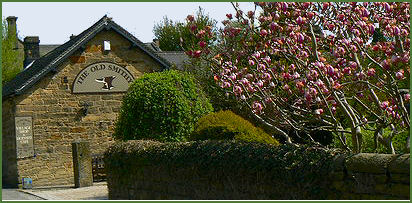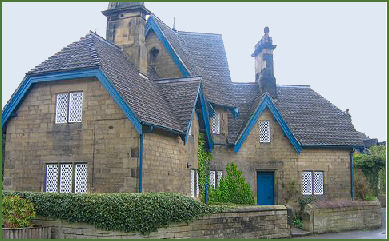Beeley
OS Grid ref:- SK264673
 The charming and tranquil Peak District village of Beeley is situated at the southern end of the Chatsworth Estate.
The charming and tranquil Peak District village of Beeley is situated at the southern end of the Chatsworth Estate.
Beeley was first recorded in the Domesday Book of 1086, where it is referred to as `Begelie'. The name is of Anglo-Saxon origin and means the woodland clearing of Bega.
Beeley Brook runs down from Hell Bank to pass the village inn, before joining the River Derwent. The characterful Devonshire Arms, (pictured left) which is situated at the heart of the village and takes its name from the Dukes of Devonshire, owners of Chatsworth House. An eighteenth century coaching inn that began life as 3 cottages, the author Charles Dickens once stayed at the inn and rumour states that King Edward VII often met his mistress Alice Keppel there. The inn serves excellent food.
Opposite the inn stand three cottages built in a triangular pattern with Dutch-gabled roofs, in a style is reminiscent of Paxton who designed the nearby estate village of Edensor. Beeley Old Hall, a listed building, dates to the seventeenth century, Charles Dickens stayed there 1860's as a guest of Augustus Mayhew. The hall is situated at the north eastern edge of the village.
 The journalist Arthur Mee wrote of the village 'Beeley has joys of its own, hidden from those who rush by. Its roads go up and down and twist and turn as they take us by houses of old grey stone, by cottage and school and old grey hall, by a little green with a lovely lime, to ancient church with sturdy tower, close to gabled vicarage.'
The journalist Arthur Mee wrote of the village 'Beeley has joys of its own, hidden from those who rush by. Its roads go up and down and twist and turn as they take us by houses of old grey stone, by cottage and school and old grey hall, by a little green with a lovely lime, to ancient church with sturdy tower, close to gabled vicarage.'
Parts of St Anne's Church date back to the twelfth century, the building was heavily restored in the nineteenth century but boasts a Norman doorway, and a tower dating to the fourteenth century. It contains some fine memorials to the Cavendish family and an ancient Yew tree, said to be older than the church, stands in the churchyard.
The Duke's Barn, a grade II listed building, was built in 1791. It once housed the cart horses which provided transport for the Chatsworth estate. The Old Smithy now serves as the village cafe and shop.
 Hob Hurt's House, a bronze age barrow, lies on heatjer clad Beeley Moor to the east of the village. The unusual rectangular barrow was originally made with 13 stones, only five of which remain today. The barrow was excavated in the nineteenth by Thomas Bateman, who uncovered a stone-lined grave containing some scorched human bones plus some lead ore. The monument is in the care of English Heritage.
Hob Hurt's House, a bronze age barrow, lies on heatjer clad Beeley Moor to the east of the village. The unusual rectangular barrow was originally made with 13 stones, only five of which remain today. The barrow was excavated in the nineteenth by Thomas Bateman, who uncovered a stone-lined grave containing some scorched human bones plus some lead ore. The monument is in the care of English Heritage.
There are many prehistoric remains on the moor, Park Gate Stone Circle consists of ten stones about 0.5 to 0.9 metres high, the diameter of the circle measures around 12 metres.
Nearby places of interest
Chatsworth House known as "The Palace of the Peak" is the country seat of the Duke of Devonshire and is situated on the banks of the River Derwent, 3.5 miles to the northeast of Bakewell in the heart of the Peak District National Park.
Haddon Hall near Bakewell, is an architectural gem. Dating back to the eleventh century, the hall has been described as "the most complete and most interesting house of [its] period", it is the finest example of a medieval manor house currently in existence in England.
